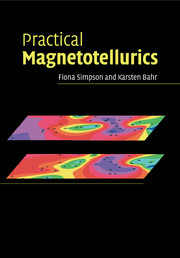Book contents
- Frontmatter
- Contents
- Preface
- Symbols
- 1 Introduction
- 2 Basic theoretical concepts
- 3 Planning a field campaign
- 4 From time series to transfer functions: data processing
- 5 Dimensionality and distortion
- 6 Numerical forward modelling
- 7 Inversion of MT data
- 8 The general link to other geosciences: conduction mechanisms
- 9 The special link to other geosciences
- 10 Other EM induction techniques
- Appendix 1 Theorems from vector calculus
- Appendix 2 The transfer function in the wavenumber-frequency domain and equivalence transfer functions
- Appendix 3 Probability distributions
- Appendix 4 Linear regression
- Appendix 5 Fourier analysis
- Appendix 6 Power and cross spectra
- Glossary
- References
- Index
4 - From time series to transfer functions: data processing
Published online by Cambridge University Press: 03 December 2009
- Frontmatter
- Contents
- Preface
- Symbols
- 1 Introduction
- 2 Basic theoretical concepts
- 3 Planning a field campaign
- 4 From time series to transfer functions: data processing
- 5 Dimensionality and distortion
- 6 Numerical forward modelling
- 7 Inversion of MT data
- 8 The general link to other geosciences: conduction mechanisms
- 9 The special link to other geosciences
- 10 Other EM induction techniques
- Appendix 1 Theorems from vector calculus
- Appendix 2 The transfer function in the wavenumber-frequency domain and equivalence transfer functions
- Appendix 3 Probability distributions
- Appendix 4 Linear regression
- Appendix 5 Fourier analysis
- Appendix 6 Power and cross spectra
- Glossary
- References
- Index
Summary
The digital time series collected during an MT survey can easily total a few Gigabytes, but the data that will finally be interpreted with numerical modelling schemes typically consist of a few hundred numbers per site that represent the frequency-dependent transfer functions. The reduction is referred to as ‘data processing’. One time series can simultaneously contain information about many periods and, therefore, about many penetration depths, and the first step in data processing involves a Fourier transformation from the time domain to the frequency domain. Data reduction is then achieved by stacking data falling within particular spectral bands in the frequency domain: both neighboured frequencies from the same segment (window) of a time series, and similar frequencies from sequential time series windows can be stacked.
What is the exact meaning of ‘transfer function’? The Earth is regarded as a linear system that responds to an input process (e.g., a time-varying magnetic field) via a predictable output process, (e.g., a time-varying electric field). The transfer function is the ratio of these processes, and because the system is linear, the transfer function does not depend on the amplitude of the input process. The estimation of the transfer functions can be hindered by noise in the input and output processes: e.g., electric and magnetic fields which are not naturally induced but are rather associated with our technical civilisation.
- Type
- Chapter
- Information
- Practical Magnetotellurics , pp. 58 - 78Publisher: Cambridge University PressPrint publication year: 2005



